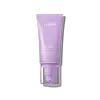What's inside
What's inside
 Key Ingredients
Key Ingredients

 Benefits
Benefits

 Concerns
Concerns

 Ingredients Side-by-side
Ingredients Side-by-side

Water
Skin ConditioningGlycerin
HumectantPolysorbate 20
EmulsifyingGlycolic Acid
BufferingButylene Glycol
HumectantHydroxyethyl Acrylate/Sodium Acryloyldimethyl Taurate Copolymer
Emulsion StabilisingCI 77891
Cosmetic ColorantHydrogenated Polyisobutene
EmollientAlcohol
AntimicrobialCitric Acid
BufferingSodium Hydroxide
BufferingSimmondsia Chinensis Seed Oil
EmollientParfum
MaskingXanthan Gum
EmulsifyingDipotassium Glycyrrhizate
HumectantPhenoxyethanol
PreservativeXylitol
HumectantPolysorbate 60
EmulsifyingSorbitan Isostearate
EmulsifyingTetrasodium EDTA
Ascorbyl Glucoside
AntioxidantSynthetic Fluorphlogopite
Malva Sylvestris Extract
AstringentHibiscus Sabdariffa Flower Extract
Skin ConditioningZea Mays Starch
AbsorbentHydrogenated Lecithin
EmulsifyingSaponins
CleansingLimonene
PerfumingPentaerythrityl Tetra-Di-T-Butyl Hydroxyhydrocinnamate
AntioxidantAframomum Angustifolium Seed Extract
Skin ConditioningPalmaria Palmata Extract
Skin ProtectingSodium Benzoate
MaskingTin Oxide
AbrasivePotassium Sorbate
PreservativeTocopherol
AntioxidantJasminum Officinale Flower Extract
MaskingCI 14700
Cosmetic ColorantWater, Glycerin, Polysorbate 20, Glycolic Acid, Butylene Glycol, Hydroxyethyl Acrylate/Sodium Acryloyldimethyl Taurate Copolymer, CI 77891, Hydrogenated Polyisobutene, Alcohol, Citric Acid, Sodium Hydroxide, Simmondsia Chinensis Seed Oil, Parfum, Xanthan Gum, Dipotassium Glycyrrhizate, Phenoxyethanol, Xylitol, Polysorbate 60, Sorbitan Isostearate, Tetrasodium EDTA, Ascorbyl Glucoside, Synthetic Fluorphlogopite, Malva Sylvestris Extract, Hibiscus Sabdariffa Flower Extract, Zea Mays Starch, Hydrogenated Lecithin, Saponins, Limonene, Pentaerythrityl Tetra-Di-T-Butyl Hydroxyhydrocinnamate, Aframomum Angustifolium Seed Extract, Palmaria Palmata Extract, Sodium Benzoate, Tin Oxide, Potassium Sorbate, Tocopherol, Jasminum Officinale Flower Extract, CI 14700
Water
Skin ConditioningGlycolic Acid
BufferingTranexamic Acid
AstringentGlycerin
HumectantHydroxypropyl Starch Phosphate
Lactic Acid
BufferingSodium Hydroxide
BufferingPentylene Glycol
Skin ConditioningPanthenol
Skin ConditioningPropanediol
Solvent1,2-Hexanediol
Skin ConditioningSclerotium Gum
Emulsion StabilisingCoccinia Indica Fruit Extract
Skin ConditioningEclipta Prostrata Extract
Skin ConditioningGlyceryl Polyacrylate
Caprylhydroxamic Acid
Amylopectin
CI 75120
Cosmetic ColorantWater, Glycolic Acid, Tranexamic Acid, Glycerin, Hydroxypropyl Starch Phosphate, Lactic Acid, Sodium Hydroxide, Pentylene Glycol, Panthenol, Propanediol, 1,2-Hexanediol, Sclerotium Gum, Coccinia Indica Fruit Extract, Eclipta Prostrata Extract, Glyceryl Polyacrylate, Caprylhydroxamic Acid, Amylopectin, CI 75120
 Reviews
Reviews

Ingredients Explained
These ingredients are found in both products.
Ingredients higher up in an ingredient list are typically present in a larger amount.
Glycerin is already naturally found in your skin. It helps moisturize and protect your skin.
A study from 2016 found glycerin to be more effective as a humectant than AHAs and hyaluronic acid.
As a humectant, it helps the skin stay hydrated by pulling moisture to your skin. The low molecular weight of glycerin allows it to pull moisture into the deeper layers of your skin.
Hydrated skin improves your skin barrier; Your skin barrier helps protect against irritants and bacteria.
Glycerin has also been found to have antimicrobial and antiviral properties. Due to these properties, glycerin is often used in wound and burn treatments.
In cosmetics, glycerin is usually derived from plants such as soybean or palm. However, it can also be sourced from animals, such as tallow or animal fat.
This ingredient is organic, colorless, odorless, and non-toxic.
Glycerin is the name for this ingredient in American English. British English uses Glycerol/Glycerine.
Learn more about GlycerinGlycolic Acid is arguably the most famous alpha hydroxy acid (AHA) with tons of research backing its benefits.
It is found naturally in sugar cane but the form used in skincare is usually synthetic for purity and stability.
Glycolic acid removes the top layer of dead skin cells to allow newer and fresher ones to emerge.
AHAs work by breaking down the structural “glue” that holds old skin cells in place. When that buildup is gone, your skin can renew itself more efficiently.
Research also shows glycolic acid stimulates collagen production, helping to firm and thicken the skin over time. This is one of its biggest advantages over other AHAs.
Overall, glycolic acid helps with:
Fun fact: Glycolic acid boosts skin hydration by helping it produce molecules that increase hyaluronic acid naturally.
To work best, glycolic acid products should have a pH between 3-4 (that’s where exfoliation is most effective but still gentle on skin).
The pH and concentration of a product are key to its effectiveness:
It is normal to feel a slight stinging sensation when using glycolic acid. This usually fades as your skin adjusts.
Because glycolic acid has the smallest molecular size in the AHA family, it can penetrate deeper, which enhances its effectiveness but also makes it more likely to irritate sensitive skin.
If your skin is very sensitive or prone to rosacea, glycolic acid may be too strong; in that case, try milder options like lactic acid or a PHA instead.
Recent studies suggest glycolic acid might even help protect against UV damage. But don’t skip sunscreen! Freshly exfoliated skin is more sensitive to the sun.
Glycolic acid is a skincare superstar. It smooths, brightens, hydrates, and firms the skin. Unless you’re highly sensitive, it’s well worth adding to your routine.
Read more about some other popular AHA's here:
Learn more about Glycolic AcidSodium Hydroxide is also known as lye or caustic soda. It is used to adjust the pH of products; many ingredients require a specific pH to be effective.
In small amounts, sodium hydroxide is considered safe to use. However, large amounts may cause chemical burns due to its high alkaline.
Your skin has a natural pH and acid mantle. This acid mantle helps prevent harmful bacteria from breaking through. The acid mantle also helps keep your skin hydrated.
"Alkaline" refers to a high pH level. A low pH level would be considered acidic.
Learn more about Sodium HydroxideWater. It's the most common cosmetic ingredient of all. You'll usually see it at the top of ingredient lists, meaning that it makes up the largest part of the product.
So why is it so popular? Water most often acts as a solvent - this means that it helps dissolve other ingredients into the formulation.
You'll also recognize water as that liquid we all need to stay alive. If you see this, drink a glass of water. Stay hydrated!
Learn more about Water